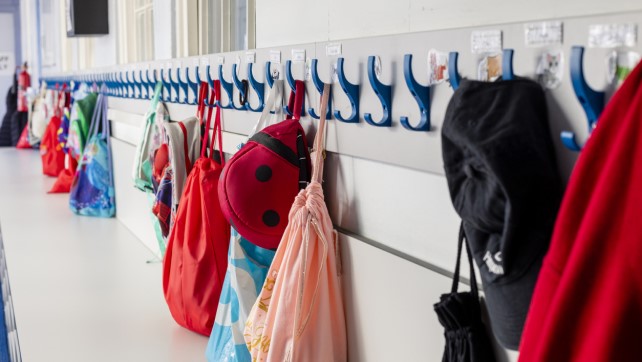Using the outdoor area to improve children’s skills
The team have high expectations of themselves and work together effectively to ensure improvements to the environment

Information about the setting
Cylch Meithrin Pontrhydfendigaid is a Welsh-medium setting that is situated in a community hall. Full day care is provided for children between two and four years old, five days a week during term time.
The setting is registered to admit 16 children and 10 children were receiving funded early years education at the time of the inspection. A majority of children come from non-Welsh-speaking homes.
The setting is a focal point of this close-knit and unique community. The main room is small but the setting has worked with the community to develop the outdoor area further. The outdoor area is available to the children throughout the session. The leader has been in post since October 2020.
Context and background to the effective or innovative practice
One of the setting’s strengths is its interactive relationship with the community. By working with the hall’s committee, the football team committee and the children’s parents, the community extended the setting’s outdoor environment. Through the conscientious work of the whole team, the outdoor area was developed to create an environment of a high standard that promotes particular skills and ignites children’s curiosity. The team have high expectations of themselves and work together effectively to ensure improvements to the environment. The budget and grants have been used efficiently and stimulating resources have been created to promote exciting, ambitious and relevant experiences for children. The role of the community has been key in creating an outdoor area of a high standard, which has a positive effect on children’s learning experiences.
Description of nature of strategy or activity
While planning the outdoor area, practitioners have succeeded in combining the children’s interests and extended their skills and independence. As a result, children develop the confidence to make mature decisions about their play and learning. They explore the wide range of areas that are available confidently and adapt resources according to their interests, for example by adapting the large car to be a work van for builders. Children make decisions to add technological resources or equipment to the provision completely independently. They enjoy using apps to track aeroplanes that fly over the setting while sitting in a wooden aeroplane in the outdoor area. Then, they examine the globe and pretend to fly to other countries. Some resources have been developed in co-operation with local businesses and these resources promote children’s independence and skills successfully.
The setting has ensured that the resources in the outdoor area provide a good level of challenge to extend children’s skills. As a result, children make independent decisions about how they would like to use the equipment and what level of challenge is most appropriate for them. For example, children choose how they would like to use the climbing equipment.
The leader ensures that she takes advantage of the expertise of staff and people in the community to improve children’s skills. Practitioners are creative when using recycled resources to create imaginative resources that are of interest to the children. For example, they create Welsh cobs from leftover pieces of wood and make a fuel or electrical pump for role-play cars.
What impact has this work had on provision and learners’ standards?
Developments in the outdoor area have had a positive effect on the children’s behaviour and well-being. They feel at ease, eager and completely confident when using the wide range of resources in the environment. The open-ended resources provide various opportunities as they play and these opportunities change in line with the children’s interests and creativity. When making choices for themselves, children are more eager to communicate and there is a spontaneous excitement to talk to others. Resources have also provided opportunities to stretch confident speakers by creating situations to enrich and deepen their understanding of language. For example, they discuss the condition of the silage or identify the area’s birds of prey.
Opportunities to make a range of decisions about their learning in the outdoor area have had an effect on the children’s perseverance skills as they concentrate for extended periods. Practitioners are able to interact skilfully with the children by encouraging them to extend their ideas and promote the children’s independence to make decisions. For example, the children understand that cement is needed to build a wall, so they get shaving foam to imitate the cement when building a wall independently. Children have taken ownership of the areas and are completely confident when considering that all of the resources are available to them throughout the session. If something is not available to them, they know that they can make it.
How have you shared your good practice?
Good practice is shared with the non-maintained sector and schools within the local authority in county-wide training on foundation learning modules. The setting’s experiences are used to exemplify the practical principles of pursuing children’s interests and the way in which this has a direct effect on children’s lives, confidence, skills and well-being.